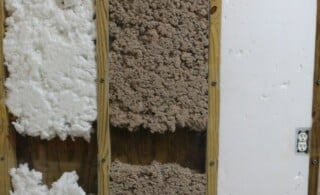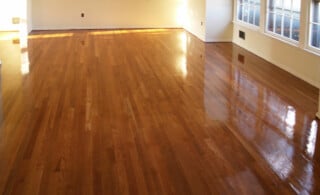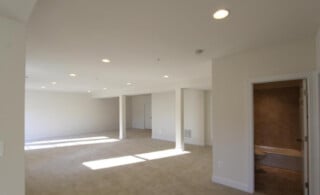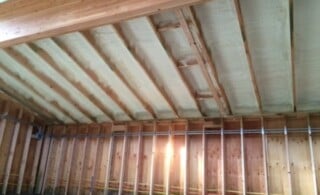 Photo: photosbysabkapl / stock.adobe.com
Photo: photosbysabkapl / stock.adobe.com
Cellulose insulation costs more per square foot than fiberglass. It’s only available as blown-in insulation, which requires special equipment to blow or pour into an enclosed existing wall or open new wall cavities, unfinished attic floors, and other hard-to-reach places. However, it doesn’t degrade, and its R-value doesn’t lessen in extreme cold or when it’s compressed.
Compression occurs when insulation is improperly installed, has boxes or heavy items stored on it (think about all the junk stored in your attic), it gets walked over regularly, it gets moisture damage, or it has compressed upon itself due to age and placement.
Fiberglass Insulation
 Photo: Dmitriy Melnikov / stock.adobe.com
Photo: Dmitriy Melnikov / stock.adobe.com
Fiberglass insulation is the more affordable option, but its R-value decreases in extreme cold or with rapid temperature fluctuations. You’ll typically see fiberglass insulation in loose-fill form or blanket (batt) insulation, which is easily fitted between studs, joists, and beams. It’s a solid, cost-effective choice but isn’t considered environmentally friendly. Fiberglass is resistant to rot and mold but does lose R-value when compressed.
Cellulose vs. Fiberglass Insulation: Which is Better?
R-Value
Best for Resisting Flow of Heat: Cellulose
R-value is the rating that expresses how effective a material is at resisting the flow of heat. The higher the R-value, the more effective the material is as an insulator.
Both cellulose and fiberglass have similar R-values, but how they perform differs considerably, and these differences make cellulose the winner in this category.
| Cellulose | |
|---|---|
| Pros | Cons |
| 3.5–3.7 R-Value
Loses less R-value when compressed Maintains R-value even in extreme cold Can withstand denser installation |
More prone to settling, which can slightly reduce R-value |
| Fiberglass | |
|---|---|
| Pros | Cons |
| 3.5–3.7 R-Value
Batts are less prone to settling |
Loses R-value in extreme cold and extreme temperature changes
Loses R-value when compressed, so cannot be too densely packed |
Cost
Most Affordable: Fiberglass
While the cost isn’t the most important factor when insulating a home, it’s still a significant consideration for most. These insulation materials have similar prices for blown-in installation, which costs $1 to $1.50 per square foot. However, cellulose is only available as blown-in insulation. So, in this category, fiberglass wins as it’s also available as batting. Fiberglass batt insulation costs $0.30 to $1.50 per square foot.
Installation
Professional Installation: Tie
Both fiberglass and cellulose are reasonably easy to install, but it’s best to leave it to a local insulation pro who can offer you a product with the right density and R-value for your home. While installation isn’t difficult, installing it well is a challenge if you don’t have the right experience. Plus, if you’re installing blown-in, you’ll need to hire the necessary equipment. And, if you go with fiberglass, there are associated health risks from inhaling the tiny glass fibers.
| Cellulose | |
|---|---|
| Pros | Cons |
| Easy blown-in installation
Professional installation is recommended DIY installation is possible |
Not available as batts
DIY installation requires equipment rental |
| Fiberglass | |
|---|---|
| Pros | Cons |
| Available as batts or blown-in
Professional installation is recommended |
Glass fibers present a potential health risk for the installer
Not well-suited to DIY installation Batts are not as efficient if installed incorrectly |
Air Flow
Best for Controlling Airflow: Cellulose
Cellulose and fiberglass insulations will not act as airflow barriers. Instead, cellulose will slow down the flow of air, and fiberglass will trap air between its fine fibers as part of the insulation process. If it settles, thermal bridges can appear in the gaps. A thermal bridge is a space, such as in a wall cavity, where the lack of effective insulation allows hot or cold air to move freely in or out.
| Cellulose | |
|---|---|
| Pros | Cons |
| Slows down airflow to retain warmth
Limits the formation of thermal bridges around joists and other obstacles Does not settle if installed at proper density |
If settling does occur, thermal bridges form in the gaps |
| Fiberglass | |
|---|---|
| Pros | Cons |
| Blown-in fiberglass reduces the risk of thermal bridges around obstacles
Creates air pockets between fibers to reduce thermal transfer |
Batts are more at risk of compression and loss of air pockets
Blown-in settles and compresses itself over time, reducing effectiveness against airflow Can create thermal bridges if batts are not installed properly or when fiberglass settles. |
Environmental Friendliness
The Greener Choice: Cellulose
Installing new insulation is a great opportunity to make your home more eco-friendly. Cellulose insulation is made from a mostly recycled organic material. And, because it’s less likely to settle, there’ll be fewer thermal bridges, so it’s more effective in trapping air and limiting energy waste.
| Cellulose | |
|---|---|
| Pros | Cons |
| Made from organic matter
Most often made from wood or paper waste Generally uses 82% to 85% recycled content Less prone to settling Reduced chance of thermal bridges Limits energy waste long-term Requires less energy to manufacture than fiberglass Results in less air pollution during production than fiberglass |
More flammable than fiberglass, even when treated for fire resistance
Not impervious to mold and pests, which can impact air quality and insulation effectiveness |
| Fiberglass | |
|---|---|
| Pros | Cons |
| Some manufacturers use 40% to 60% recycled glass fibers
Available in high-density variants that improve efficiency in areas of limited cavity space Can improve a home’s energy efficiency when installed correctly |
If it gets wet, fiberglass is rendered ineffective and will waste energy
If it gets compressed, fiberglass is less effective Can transmit airborne glass fibers, which are considered a pollutant Irritates lungs and skin, causing coughing and itchy skin upon contact Requires more energy to manufacture Produces more pollutants during production than cellulose More prone to compression and settling |
Which Insulation is Best for Your Home?
Which is Best for Cold Climates?
Cellulose insulation is the best option for cold climates because it handles temperature extremes and fluctuations more effectively than fiberglass. Once outdoor temperatures fall below freezing, fiberglass loses R-value because of the way it insulates. Fiberglass creates small air pockets, which aren’t conducive to handling the difference in interior and exterior temperatures. Cellulose insulation does not break down or lose its R-value in extreme cold, which makes it better insulation in cold climate areas.
Which is Best for Retrofitting Exterior Walls in Existing Properties?
Cellulose insulation is best for upgrading insulation in the exterior walls of old properties. Installers can blow it into wall cavities without having to remove drywall. It’s more environmentally friendly, too, particularly if you choose insulation with a high percentage of recycled material. Cellulose is designed for dense-pack situations such as retrofitting exterior walls and flows around objects and impediments, such as wiring or beams inside the cavities, significantly reducing the likelihood of thermal gaps.
Cellulose vs. Fiberglass vs. Foam Insulation
If you waste a lot of energy to keep your house comfortably cool or warm, then you’ve got an air leakage problem. Fiberglass and cellulose are ineffective at mitigating drafts and cold spots because they do not perform as airflow barriers.
However, foam insulation does stop air leakage when it is properly installed. Foam insulation costs more than fiberglass and cellulose (about $0.44 to $1.50 per board) but does help to improve a home’s carbon footprint by reducing heat transfer and energy waste. Whether you’re insulating an attic or wall cavities, foam insulation is a good option for energy efficiency.
Consult With a Insulation Pro Today Fiberglass Insulation: A Simple Energy Saver
Fiberglass Insulation: A Simple Energy Saver  The Best Insulation Type for Your Garage
The Best Insulation Type for Your Garage  Insulating a Wood Floor
Insulating a Wood Floor  How to Avoid a Disaster with Basement Insulation
How to Avoid a Disaster with Basement Insulation  Sheet Foam
Sheet Foam 

Are You Familiar With This Topic? Share Your Experience.